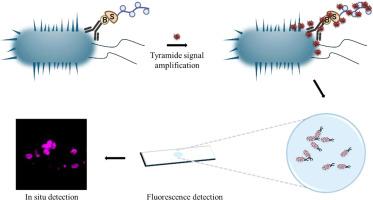基于单克隆抗体的沙门氏菌荧光单细胞成像选择性酪酰胺信号放大检测
IF 6.8
1区 农林科学
Q1 FOOD SCIENCE & TECHNOLOGY
Innovative Food Science & Emerging Technologies
Pub Date : 2025-09-11
DOI:10.1016/j.ifset.2025.104229
引用次数: 0
摘要
沙门氏菌是最常见的食源性病原体之一。本研究利用广谱抗沙门氏菌单克隆抗体和酪酰胺信号放大技术,建立了一种检测沙门氏菌的超灵敏成像方法。所使用的单克隆抗体是这样设计的,它对多种沙门氏菌血清型表现出高亲和力,包括鼠伤寒、肠炎和其他。通过随后的酪酰胺信号放大,我们成功地在荧光显微镜下看到了单个细菌细胞的明亮荧光图像。该方法对纯培养和人工污染鸡液中鼠伤寒沙门氏菌的检出限均低至100 CFU/mL,且与对照菌株无交叉反应。结果表明,该方法对13种常见的沙门氏菌血清型进行了灵敏、广谱的检测,既适用于纯化细菌样品,也适用于真实鸡肉样品。该方法不需要耗时的扩增或培养步骤,可在4小时内完成,具有足够的灵敏度,可直接检测致病菌。该技术可用于沙门氏菌污染的临床检测、食品安全评价和环境监测。本文章由计算机程序翻译,如有差异,请以英文原文为准。

Ultrasensitive monoclonal antibody-based Salmonella detection through fluorescence single bacterial cell imaging selectively enhanced by tyramide signal amplification
Salmonella is one of the most common foodborne pathogens. In this work, we developed an ultrasensitive imaging method for the detection of Salmonella by using broad-spectrum anti-Salmonella monoclonal antibody and the tyramide signal amplification technique. The monoclonal antibody used was designed in such a way that it exhibited high affinity for a wide range of Salmonella serotypes, including Typhimurium, Enteritidis and others. Through subsequent tyramide signal amplification, we successfully visualized bright fluorescent images of single bacterial cells through fluorescence microscopy. The detection limit of the method is as low as 100 CFU/mL for S. Typhimurium in both pure culture and artificially contaminated chicken rinsates, and no cross-reactivity with control bacterial strains was observed. We demonstrated that this method provided sensitive and broad-spectrum detection of 13 serotypes of common Salmonella, both in purified bacterial samples and in real chicken meat samples. This method does not require time-consuming amplification or culture steps and can be completed within 4 h, making it sensitive enough to detect pathogenic bacteria directly. This technique can be applied for clinical testing, food safety assessment, and environmental monitoring of Salmonella contamination.
求助全文
通过发布文献求助,成功后即可免费获取论文全文。
去求助
来源期刊
CiteScore
12.00
自引率
6.10%
发文量
259
审稿时长
25 days
期刊介绍:
Innovative Food Science and Emerging Technologies (IFSET) aims to provide the highest quality original contributions and few, mainly upon invitation, reviews on and highly innovative developments in food science and emerging food process technologies. The significance of the results either for the science community or for industrial R&D groups must be specified. Papers submitted must be of highest scientific quality and only those advancing current scientific knowledge and understanding or with technical relevance will be considered.

 求助内容:
求助内容: 应助结果提醒方式:
应助结果提醒方式:


